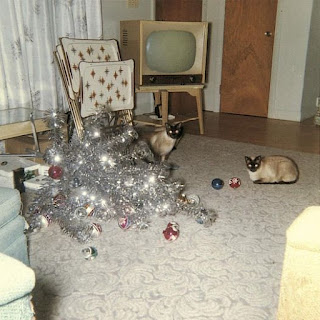To explain the aluminum tree phenomenon, it is important to look back at where we were in the late 1950s and early 1960s. This was a time of prosperity for most Americans and a time when people were actively looking to the future with enthusiasm. The possibilities must have seemed endlessly golden for the adults at that time. These were people who had made it through the Great Depression, World War II, and the Korean War, and they were ready for something new to look forward to. Combine that attitude with the economic security of well-paying jobs and emerging technologies from the space program, and the market for gadgets and gimmicks was well set. The American people were excited about the prospect of space exploration and wanted to be a part of this new world in some small way. So, they bought Tang and Teflon pans and Christmas trees that looked like something the Jetsons would have.
Cultural shifts often have humble beginnings (Microsoft began in a garage, after all), and for the aluminum tree we all think of, the beginning was in the small city of Manitowoc, Wisconsin. For any number of reasons, Manitowoc had been a center of aluminum production since the late 1800s. The factories there provided good incomes for thousands of residents, and by mid-century, there were many new aluminum products on the market to keep them busy. Then, in late 1958, an employee of Aluminum Specialty Company in Manitowoc saw an aluminum tree that another company had created. But that tree was expensive and hard to assemble, so it wasn’t selling. Seeing an opportunity, the dedicated employee took the tree to the engineers at Aluminum Specialty. Within a few months, they had designed an affordable, portable tree that was easy to assemble. By Christmas 1959, the Evergleam model was rolling out and selling big. The innovative employee’s name has been lost to time, but hopefully, he was rewarded handsomely for his vision.In 1965, A Charlie Brown Christmas was beamed into living rooms across the country. Charlie Brown (and other characters from Peanuts) had been loved by readers of Sunday comics since the late ’40s, but this was their first primetime special for the whole family. In the show, Lucy wants Charlie to buy a pink aluminum tree, but he chooses – and loves - his now-famous threadbare but real tree. This was seen by many as an overt protest against crass consumerism and a rallying cry to embrace the real, and flawed, natural world. After the broadcast, aluminum tree sales quickly tapered off and then crashed significantly as Charlie Brown’s Christmas became an annual favorite. Aluminum Specialty Products had remained the leader in aluminum trees; but by 1969, they had ceased production of their glittering Evergleam trees.
Luckily, at the same time that aluminum trees were popular, cheap cameras and film were also available. This means that there is a delicious trove of photographs showing people by their trees. These images capture that short period of time in all its garish glory. Here, for instance, is a collection of every-one-is-better-than-the-next pictures. Some of these have a strangeness to them that is outright hilarious or definitely creepy. Or something else entirely that I cannot name. Enjoy.











No comments:
Post a Comment